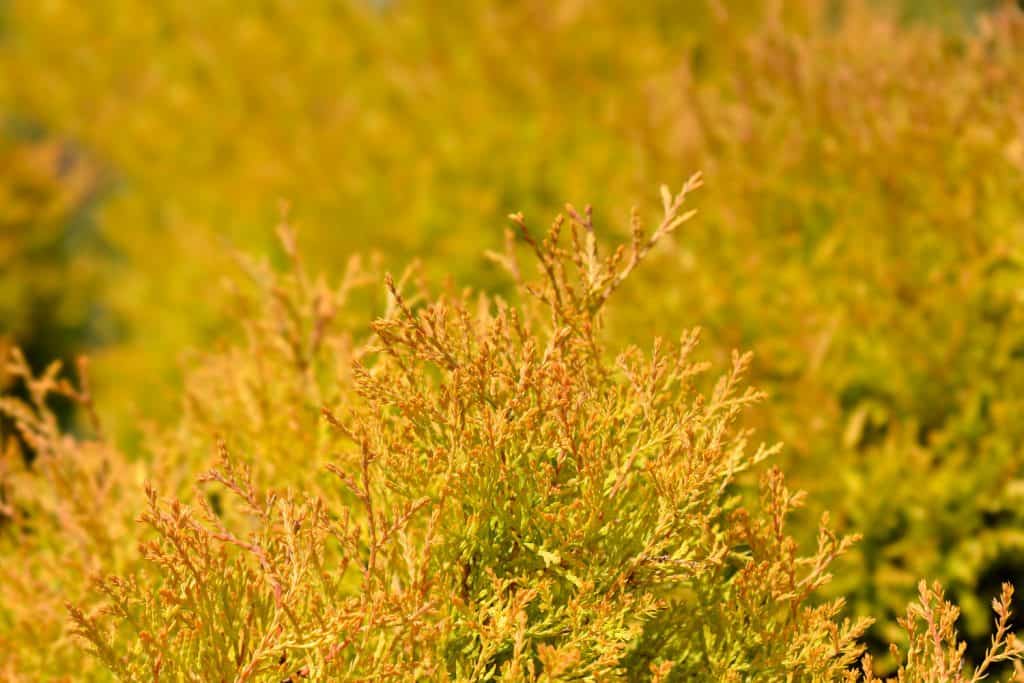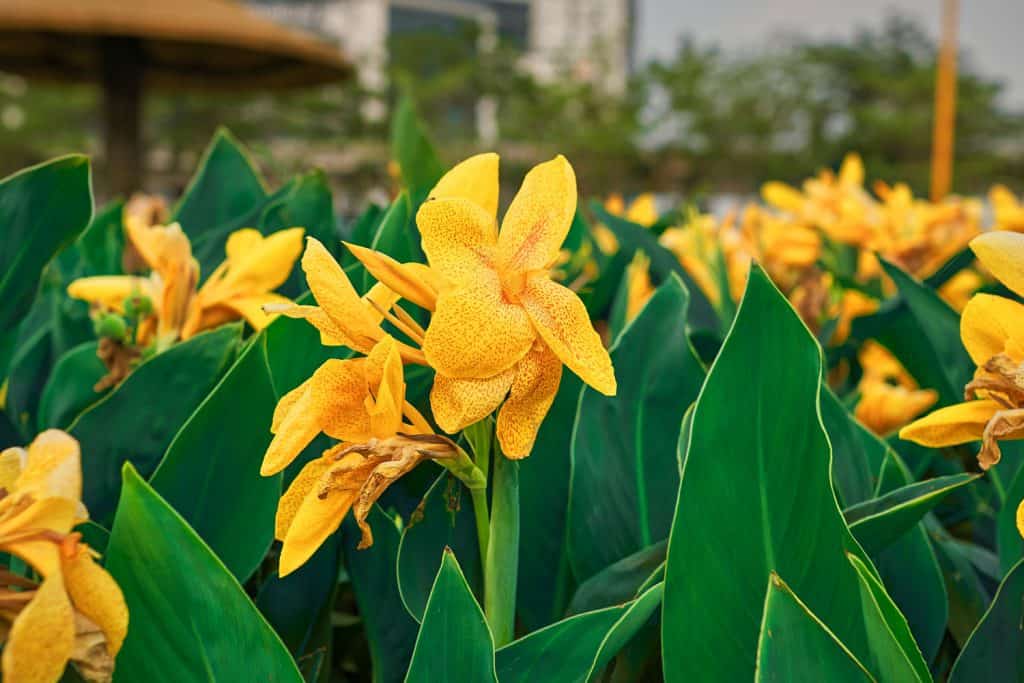Not all plants can thrive in any condition. That's why it is important to research the type of soil you have and what plants will do well in it. If you not only have clay soil but also live in an area that sees a lot of moisture, you will need to find plants that can survive in wet clay soil. Fortunately for you, we've compiled a list of the 11 best plants for wet clay soil. Take a quick look at the list below and then keep scrolling for information about each one.
The best plants for wet clay soil are:
- Asters
- Daylilies
- Fire Chief Arborvitae
- Abelia Grandiflora Plants
- Canna Lily
- Hardy Hibiscus
- Black-eyed Susans
- Creeping Jenny
- Smooth Hydrangeas
- Hostas
- Siberian Iris
These are 11 of some of the best plants for wet clay soil, but now it's time to discuss each one. We'll go over what each plant looks like, which zones they will do well in, and some basic growing instructions. We'll even provide images of each one so you can see what they might look like in your yard. Let's begin!

The Best Plants For Wet Clay Soil
The list we have compiled includes shrubs, flowers, and evergreens that will do well in clay soil. All of the plants listed will also do well in moist soil. Some of them will not thrive in heavily saturated areas of soil, and we've made sure to mention this in each description, so keep this in mind along with how wet your soil is as you read about each one.
1. Asters (Symphyotrichum)

Aster plants are perennials that have small daisy-like flowers. They will bloom towards fall and are available in a variety of pretty colors. Asters are a great plant to attract butterflies, bees, and hummingbirds.
Asters that do well in moist clay soil are New England Asters (Symphyotrichum Novae-Angliae), and these will grow in zones 4-8. These asters prefer moist soil in full sun, so if your area is shaded, another plant might be better a better option for you.
2. Daylilies (Hemerocallis)

Another bright, colorful flower, daylilies are one of the easiest plants to grow because they can do well in any type of soil. For clay soils, adding some peat moss to the soil before planting will help the daylilies thrive.
These plants grow best in zones 4-9 and require minimum care. However, they do best in moist soils that aren't overly wet, so if the ground is too saturated, you may have trouble getting them to grow without any problems.
3. Fire Chief Arborvitae (Thuja Occidentalis 'Congabe')

This plant is an evergreen shrub that can offer a burst of color to your landscape year round. While it will do well in clay and moist soils, it can succumb to root rot if the soil is too wet.
Other than this, it's an easy-to-maintain shrub that likes full sun to partial shade. Unlike other evergreens, it doesn't require pruning and can also survive drought conditions. Fire Chief Arborvitae grows in zones 5-9.
4. Abelia Grandiflora Plants (Linnaea Grandiflora)

Another hearty shrub, Abelia Grandiflora can do well in most soil types and conditions. As a member of the honeysuckle family, dainty honeysuckle flowers will appear when the plant blooms.
To encourage its best growth, you should combine your heavy clay soil with some organic matter such as sand or peat moss before planting the shrub. Abelia Grandiflora likes moist soil and will do best in zones 5-9.
5. Canna Lily (Canna Indica)

Unlike some of the other plants we've mentioned, Canna Lilies do like soil on the wetter side which makes them perfect if you have an area that sees a lot of water. They can thrive in most soil conditions, but some soil types like clay will require some additional preparation.
In order for Canna Lilies to grow well in clay soil, you should add compost to the soil mixture. Canna Lilies do require a sunny spot in order for them to bloom, and they grow best in zones 7-10.
6. Hardy Hibiscus (Hibiscus Moscheutos)

Hardy Hibiscus is just that—hardy. They can grow in heavy wet clay soil. Hardy hibiscus does prefer acidic soil, so you may need to increase the acidity of your soil before you plant them. You can do this by adding peat moss or compost and combining it with the clay soil.
Hardy hibiscus also prefers full sun, so make sure to plant them in a sunny spot so you can get the best bloom from them. These plants will grow in zones 5-9 which is a much wider range than their tropical counterparts.
Click here to see this peat moss on Amazon.
7. Black-Eyed Susans (Rudbeckia Hirta)

Another flower that can tolerate any soil type, Black-Eyed Susans are popular among gardeners for their tough but beautiful daisy-like flowers. They are also popular because of their ability to grow in a wide range of zones from zones 3-10.
Unlike the Hardy Hibiscus, Black-Eyed Susans do not like acidic soil and prefer to grow in soil with a neutral pH, so it's probably not best to try and grow these two plants together.
8. Creeping Jenny (Lysimachia Nummularia)

Creeping Jenny does well in damp soil and will happily spread throughout your garden. Because of this, it's best if they are kept away from other plants they could damage. Clay soil is one of Creeping Jenny's preferred soil types, which makes them one of the best plants for your soil type.
It's important to not let the soil dry out and to keep the plant in full sun to partial shade in order for them to thrive. Creeping Jenny will do best in zones 4-9.
9. Smooth Hydrangeas (Hydrangea Arborescens)

Smooth Hydrangeas can do well in heavy clay as long as the water isn't hanging around in the soil too long. These plants do like consistently moist soil, but if water isn't draining enough, it can lead to some problems. When it next rains, take note of how long it takes for the water to drain.
Also, this is another plant that you might have to amend the soil for. You can do this by mixing in some organic matter. So while this plant may take a little more work to grow, it does offer a stunning visual if you succeed.
10. Hostas

Hostas, also referred to as Plantain Lilies, are popular because they are known for being easy to grow and reliable. They can grow in moist heavy clay soil and require little work.
Amending the soil can help promote better growth from your Hostas, but they can typically tolerate the clay soil as is. If you do choose to amend your soil, one recommended product is John & Bob's Soil Optimizer.
These plants are one of the few plants we've discussed that do not require full sun, making them a great option for those with shadier yards. They will grow best in zones 3-9.
Click here to see this soil optimizer on Amazon.
11. Siberian Iris (Iris Sibirica)

We have truly kept the best for last with this plant. Siberian Iris plants thrive in wet, heavy clay soil. You can't find a plant more suited for your type of yard than this one. It's a beautiful flowering plant that you'll see from late spring to early summer.
It will grow in zones 2-9 but may require full sun in cooler climates. Siberian Iris plants do well in neutral to slightly acidic soil and can be planted any time from spring to fall.
Still won't grow?
While there are plenty of options for plants that will grow in wet clay soil, you may have to amend the soil in order to be successful.
If you still struggle to get plants to grow, many people choose to add raised flower beds rather than plant directly into the ground. This allows you to create an ideal soil mix and ideal conditions for the plants you wish to grow.
Final Thoughts
You may have been feeling concerned that planting anything in your soil type was a lost cause. We hope this guide has proven that doesn't have to be the case.
There is plenty of options and plenty of plant varieties that can grow well in wet clay soil. Now, with any luck, you should have more of an idea of which plants will work best for you. If all else fails, don't be afraid to add some raised flower beds to your yard! Happy planting!
For more inspiration about what to plant in wet clay soil, take a look at some of our other blog posts below:
15 Shrubs For Wet Clay Soil That Will Look Great In Your Garden
15 Trees For Wet Clay Soil That Are Great For Landscaping
If instead of flowers, trees, and shrubs, you would rather try your hand at growing vegetables in your clay soil, take a look at this blog post: How To Amend Clay Soil For Vegetable Gardening


